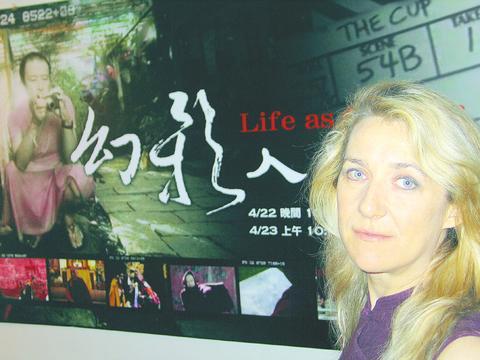Life as Cinema by Anika Tokarchuk is a 56-minute documentary about the making of The Cup (1999) (高山上的足球盃), the debut feature film of Dzongsar Khyentse Rinpoche (aka Khyentse Norbu).
Dzongsar Khyentse Rinpoche, a spiritual director of several Buddhist colleges in India, Bhutan and Sikkim, is recognized in his culture as the third incarnation of the Khyentse lineage of Tibetan Buddhism. Life as Cinema voices his Buddhist reflections on the impermanence of life.

PHOTO: BEN ZULLO
The film begins with Dzongsar Khyentse Rinpoche making a shadow butterfly on the wall with his hands. While the butterfly's magnified shadow flaps its dark wings on a white wall, he asks, "How do you know this is a butterfly?"
The shadow on the wall is like reality projected on the screen of our mind. The layers of illusion and reality are interwoven into each other. While the theme of illusion is dominant in the film, the encounter between modernity and tradition in everyday Tibetan culture is also telescoped into Dzongsar Khyentse Rinpoche's character.
Educated in London and given his first movie-related job by Bernardo Bertolucci in Little Buddha, Dzongsar Khyentse Rinpoch rides the tide of westernization and redefines his role as a Rinpoche.
When Tokarchuk informs the Dalai Lama that Dzongsar Khyentse Rinpoche is making a feature film based on the real events of the monks at Dzongsar Institute, he breaks into laughter commenting, "Oh, I see, lamas are actors now."
As she reveals in her documentary, the actors in The Cup are all from a real monastery and cast by their ecclesiastical superior. (Dzongsar Khyentse Rinpoche coaxed 14-year-old Jamyang Lodro into playing the role of Orgyen in The Cup with a promise of taking him to Disneyland.)
Jovial and with a sense of absurdity, Life as Cinema rings quiet notes of political urgency. Unlike other dramas on Tibet such as Kundun (1997) and Seven Years in Tibet (1997), Tokarchuk does not portray Tibet as mired in Chinese suppression. Instead, Life as Cinema tracks the footsteps of Tibetan Buddhists to India, France, England, Canada, Hong Kong, and of course Taiwan.
It is, after all, a documentary on Tibet-on-the-move, a film on the nature of change and openness.
The second part of the trilogy will go into the background of Dzongsar monastery in Tibet and focus on Karpu Lama, a Tibetan who now lives in Taiwan.
In a partial preview, Karpu's exile from Tibet is captured in a soliloquy that drifts across beautifully crafted images of Tibetan valleys and Taipei's streets. "Life is dreamlike," says Tokarchuk, "but it is also telling a history."
For your information :
There will be a free public screening of Life as Cinema at the Wisteria Tea House (

June 2 to June 8 Taiwan’s woodcutters believe that if they see even one speck of red in their cooked rice, no matter how small, an accident is going to happen. Peng Chin-tian (彭錦田) swears that this has proven to be true at every stop during his decades-long career in the logging industry. Along with mining, timber harvesting was once considered the most dangerous profession in Taiwan. Not only were mishaps common during all stages of processing, it was difficult to transport the injured to get medical treatment. Many died during the arduous journey. Peng recounts some of his accidents in

“Why does Taiwan identity decline?”a group of researchers lead by University of Nevada political scientist Austin Wang (王宏恩) asked in a recent paper. After all, it is not difficult to explain the rise in Taiwanese identity after the early 1990s. But no model predicted its decline during the 2016-2018 period, they say. After testing various alternative explanations, Wang et al argue that the fall-off in Taiwanese identity during that period is related to voter hedging based on the performance of the Democratic Progressive Party (DPP). Since the DPP is perceived as the guardian of Taiwan identity, when it performs well,

A short walk beneath the dense Amazon canopy, the forest abruptly opens up. Fallen logs are rotting, the trees grow sparser and the temperature rises in places sunlight hits the ground. This is what 24 years of severe drought looks like in the world’s largest rainforest. But this patch of degraded forest, about the size of a soccer field, is a scientific experiment. Launched in 2000 by Brazilian and British scientists, Esecaflor — short for “Forest Drought Study Project” in Portuguese — set out to simulate a future in which the changing climate could deplete the Amazon of rainfall. It is

The Taiwan People’s Party (TPP) on May 18 held a rally in Taichung to mark the anniversary of President William Lai’s (賴清德) inauguration on May 20. The title of the rally could be loosely translated to “May 18 recall fraudulent goods” (518退貨ㄌㄨㄚˋ!). Unlike in English, where the terms are the same, “recall” (退貨) in this context refers to product recalls due to damaged, defective or fraudulent merchandise, not the political recalls (罷免) currently dominating the headlines. I attended the rally to determine if the impression was correct that the TPP under party Chairman Huang Kuo-Chang (黃國昌) had little of a